
 Home Home |
 For authors For authors |
 Submission status Submission status |
 Current Current
|
 Archive Archive
|
 Archive
(English) Archive
(English)
|
 Search Search |
Laser ablation into liquid (LAL) is used to produce nanoparticles (NPs). Ultra-short ablation (femto- picosecond fs/ps-LAL) and nanosecond ablation (ns-LAL) are available. During fs/ps-LAL, cavity nucleation occurs beneath the irradiated surface. Then the detachment of the spallation layer (SpL) takes place. In the fs/ps-LAL, nucleation, foaming, and disintegration of the SpL significantly affect the number and size distribution of the resulting NPs.
There is no subsurface nucleation during ns-LAL considered here. There is no SpL, no capillary decay of the SpL. Then the standard process of NPs formation consists of three links: (1) evaporation - (2) diffusion in the receiving substance (which is air or liquid; in our case, liquid/water, see Figure) - (3) condensation.
At absorbed fluences F~1 J/cm2, the gold-water contact boundary (cb) is a few nanoseconds above the critical point in the gold phase diagram – this is the supercritical time interval. The importance of this circumstance is great. At this time interval the capillary barrier disappears, which should be overcome by evaporation (surface tension is zero). Then, firstly, the diffusion flux is sharply intensified and, secondly, cooling of the evaporating melt due to large heat of evaporation disappears. Thus, link 1 in the 1-2-3 chain drops out. Link 1 drastically reduces the amount of LF, see figure.
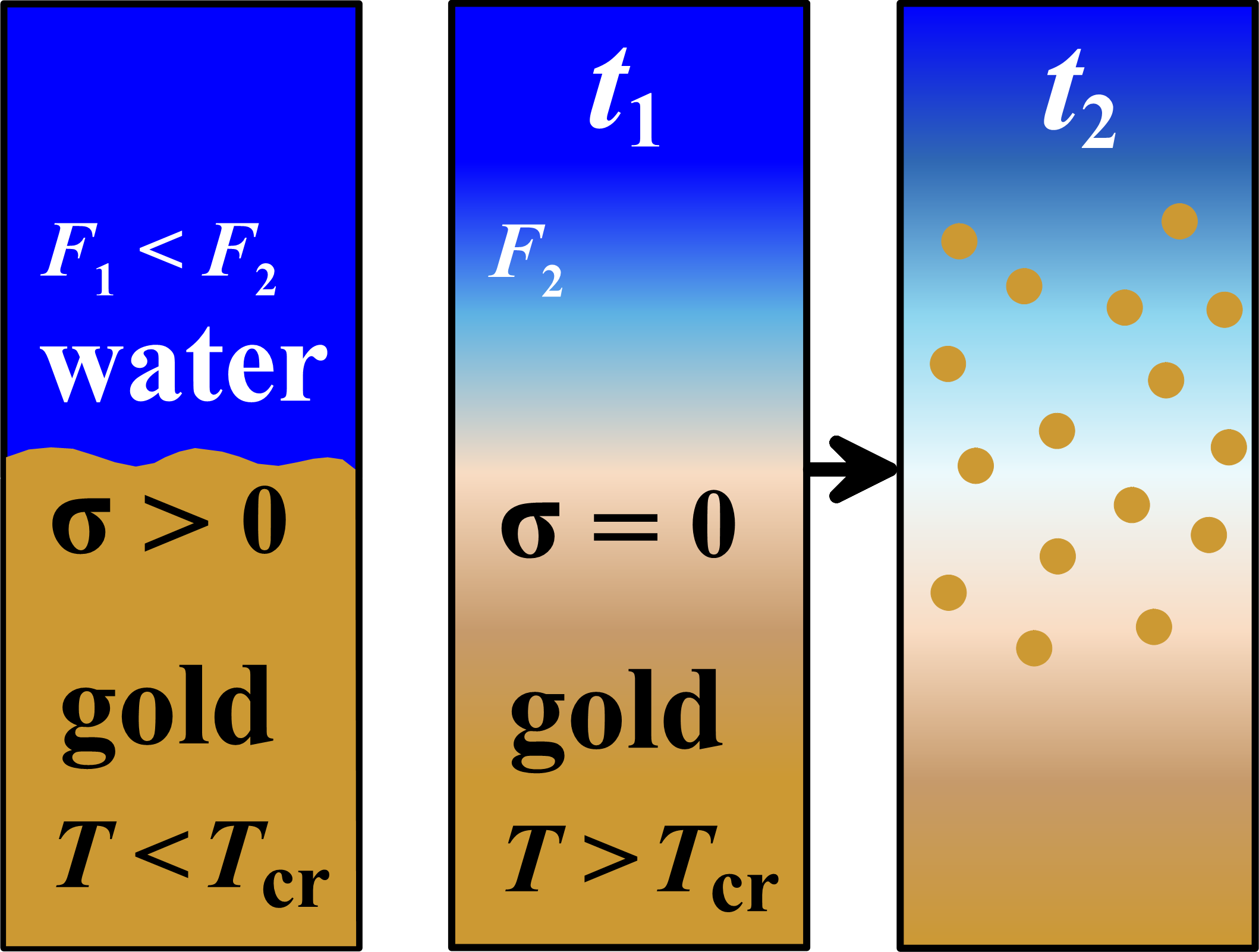
In the case of supercritical states, the entropy of gold Scb at contact boundary (cb) exceeds the critical entropy Scr. Gold of the [Scb-Scr] segment of the material profile comes under the binodal through the condensation curve (cc); except for the amount that diffused through point “cb” into the water. However, gold [Scb-Scr] does not form NPs!
Split the segment [Scb-Scr] into layers “S”: Scb > S > Scr. The layers “S” cross the condensation curve sequentially from lower entropy values to higher values. Consider two adjacent layers Scc > S of this sequence. Let the layer Scc cross the condensation curve “cc” at time t. Layer S must be in a two-phase state with saturated vapor pressure Psat(S,t). Pressure Psat(S,t) is less than the pressure Pcc = Psat(Scc,t). Therefore, the two-phase layer S collapses (shrinks) into a one-phase liquid. Accordingly, there is no NP contribution from the S layer.
N. A. Inogamov, V. V. Zhakhovsky, V. A. Khokhlov
JETP Letters 115, issue 1 (2022)
In this study, Auroral Kilometric Radiation (AKR) is used as a remote diagnostic tool for processes in the Earth's magnetosphere. Using satellite data and the spectrum of AKR fluctuations at different frequencies, we study fractal properties of the auroral region of the magnetosphere depending on the source height and the radiation generation frequency. Scaling is used to determine fractal characteristics (Hurst exponent and fractal dimension) of the medium in the region of AKR generation and their dynamics depending on the height and frequency. It is shown that with an increase in height (or, which is the same, with a decrease in signal frequency), the value of scaling and Hurst exponent increases, while the fractal dimension decreases with height. We considered different cases of AKR registration under various geomagnetic conditions, when AKR intensity differed by an order of magnitude; however, there is a steady trend towards a decrease in the fractal dimension with height during the AKR generation. The obtained values of the scaling and fractal parameters indicate that the processes under consideration exhibit self-similarity and long-range dependence.
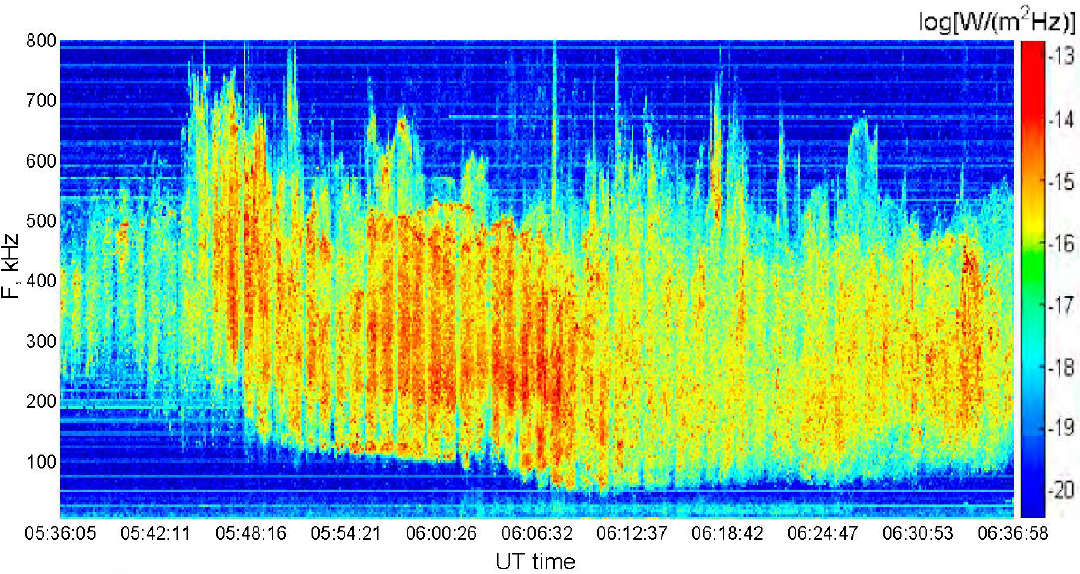
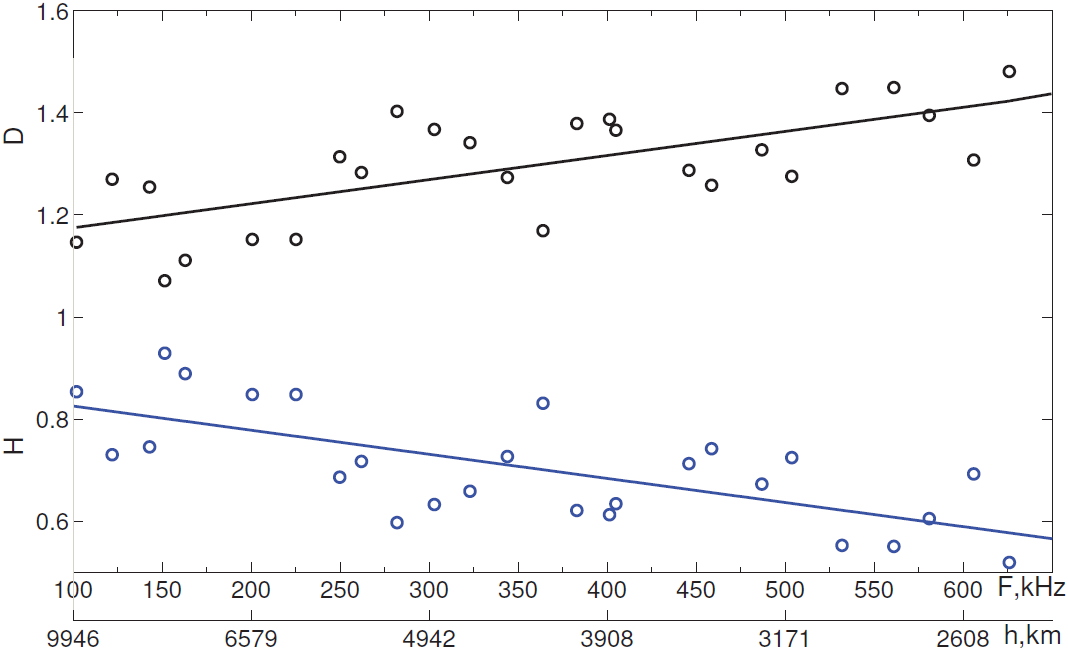
Upper panel is a dynamic spectrogram of the AKR power according to measurements from the Interbol-2 satellite for November 22, 1997. Bottom panel is dependence of fractal dimension D and Hurst exponent H on height and frequency.
A.A. Chernyshov, D.V. Chugunin and M.M. Mogilevsky
JETP Letters 115, issue 1 (2022)
Recently, it was reported the observation of acoustically induced transparency (AIT) of stainless-steel foil for resonant gamma-ray photons with an energy of 14.4 keV emitted from a radioactive Mossbauer source 57Co [1]. Similar to the electromagnetically induced transparency (EIT) and Autler–Townes splitting (ATS), AIT constitutes the appearance of a spectral domain of very weak absorption of radiation, located at the place of a nuclear resonant spectral line (Fig.1). However, in contrast to EIT and ATS, AIT doesn’t require a strong coherent electromagnetic driving field and can occur already in a two-level system. AIT is caused by coherent uniform oscillations of nuclei with ultrasonic frequency, which can be implemented by piston-like vibration of a solid absorbing medium. Similar to EIT and ATS, the material dispersion in the AIT spectral window has a sharp slope (Fig.1), which corresponds to a decrease in the group velocity of propagating radiation. In this paper, we show that under the same experimental conditions as in [1], single 14.4 keV photons emitted by the 57Co source can be slowed down below 6 m/s at room temperature in a stainless-steel foil of a certain thickness, enriched with 57Fe nuclide, oscillating at an optimal frequency. The corresponding single-photon wave packet of gamma radiation having a duration of about 80 ns can be delayed by about 100 ns.
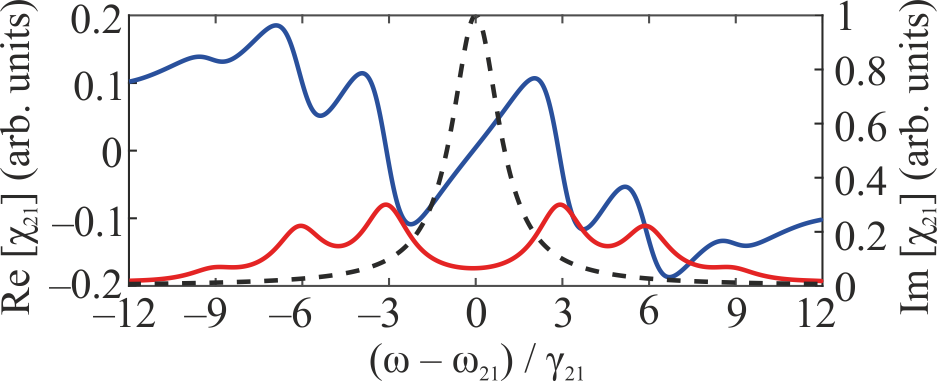
Fig. 1. Absorption (red curve, right axis) and dispersion (blue curve, left axis) of the vibrating resonant absorber 57Fe in the case of AIT in the laboratory reference frame, at the vibration amplitude of 0.38 $\lambda $ (where $\lambda $ is the radiation wavelength) and frequency of 3$\gamma_{21}$ (where $\gamma_{21}$ is the halfwidth of the nuclear absorption line). The black dashed curve (right axis) is the absorption line of the motionless absorber. In the case of the incident wave packet with Lorentz spectrum of the halfwidth $\gamma_{21}$ , the black dashed curve also represents the incident field spectrum.
[1] Radeonychev, Y.V., Khairulin, I.R., Vagizov, F.G., Scully, M. & Kocharovskaya, O. Observation of acoustically induced transparency for $\gamma $-ray photons. Phys. Rev. Lett. 124, 163602 (2020).
Y. V. Radeonychev, I. R. Khairulin, and Olga Kocharovskaya
JETP Letters 114, issue 12 (2021)
Multicharged ions, positive ions with a large ionization multiplicity, play a significant role in the processes occurring in high-temperature laboratory and astrophysical plasma. Their properties are important for X-ray astronomy and astrophysics, in the physics of ion thermonuclear fusion, for the study of the interaction of ions with matter, in medicine, etc.
Among the most important characteristics of ions are their potentials (in volts) or ionization energies (in electron volts) numerically coinciding with them. For light elements, almost all ionization energies have been experimentally measured, but in medium and heavy ions, only the first few have been measured. These values for multicharged ions are obtained either by semiempirical methods or as a result of the application of various theoretical models.
The totality of available data on the ionization energies $I_{N_e}(Z)$ (eV) of atoms and ions for elements with atomic numbers $Z \leq 110 $ is presented in the tables of National Institute of Standards and Technology (NIST). However, the use of extensive tables in practice is not very convenient. The need for a sufficiently accurate approximation of tabular data determined the motivation of our study, which considered ions with the number of electrons $N_e\leq 46$ of elements with atomic numbers of $55 \leq Z \leq 95$.
Ions are often considered in isoelectronic series, grouped by the number of electrons $N_e$ in them coinciding with their number in neutral atoms. For example, hydrogen-like ions with $N_e=1$, helium-like ions with $N_e=2$, and so on.
In our work it is shown that in such series the atomic number similarity law is fulfilled. This means that the ionization potentials of the ions in the reduced coordinates are almost parallel lines that are well approximated by quadratic polynomials (see Fig.1). This makes it possible, knowing the ionization potentials of several elements of the isoelectronic series, to estimate with good accuracy the ionization potentials of ions for other elements.
However, information is usually required on the ionization potentials of an element with an atomic number of $Z$ depending on the number of electrons $N_e$ in the ion. Therefore, the next step was to analyze the dependence of quadratic interpolation coefficients on the number of electrons. Their polynomial interpolation made it possible to estimate the ionization energies of 1886 ions with an accuracy of a fraction of a percent on the basis of four small tables.
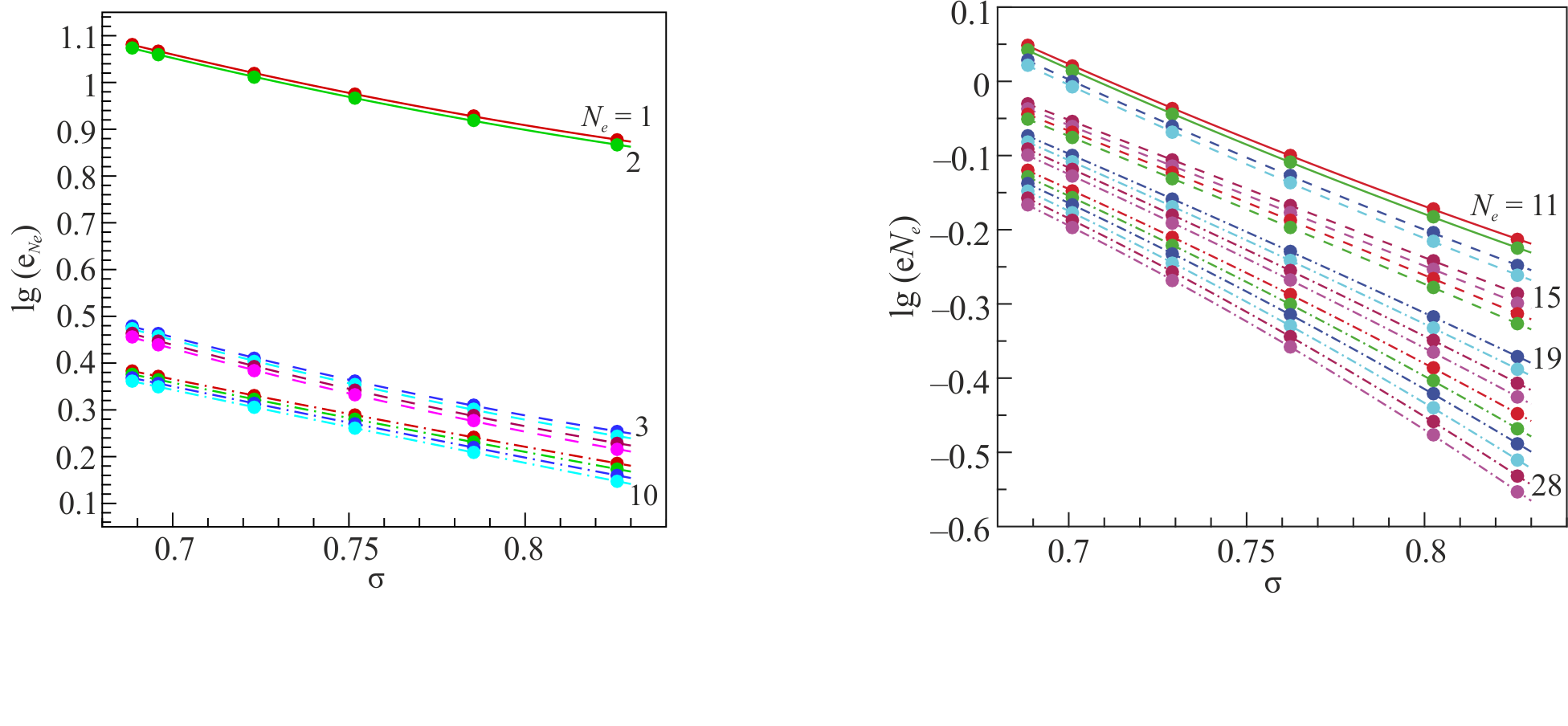
Ionisation energies from database NIST (symbols) in the reduced coordinates. $K$ and $L$ shells are on the left, $M$ shell is on the right. Lines are quadratic interpolations.
G.V.Shpatakovskaya
JETP Letters 114, issue12 (2021)
The study of the energy structure of materials with a nontrivial topology, as well as their topological classifications when intersite Coulomb interactions (ICI) are taken into account, constitutes one of the main directions of the theory of condensed matter. The correctness of describing the ICI in topological insulators (TI) is of particular interest since in these materials there is an overlap of the initial valence band and the conduction band. To emphasize the importance of this circumstance it is sufficient to note that when conduction band overlaps with valence one the inclusion of ICI can radically change the structure of the ground state through the formation of an excitonic dielectric phase.
In this work within framework of the BHZ+V model, which reflects the energy structure of the HgTe quantum well and for which ICI are taken into account the problem of the spectrum of bulk and edge states was solved. It is shown that charge fluctuations lead to a qualitative renormalization of the TI energy structure: the Fermi spectrum consists of not only of the conduction and valence bands, but also of two fluctuation states bands (FSB). This spectrum is shown in the left panel of Fig.1.
The energies of the edge states are located between the upper and lower FSB (right panel Fig.1). The dielectric gap is determined by the energy interval between the bottom of the FSB of conductions electrons and the top of the valence FSB.
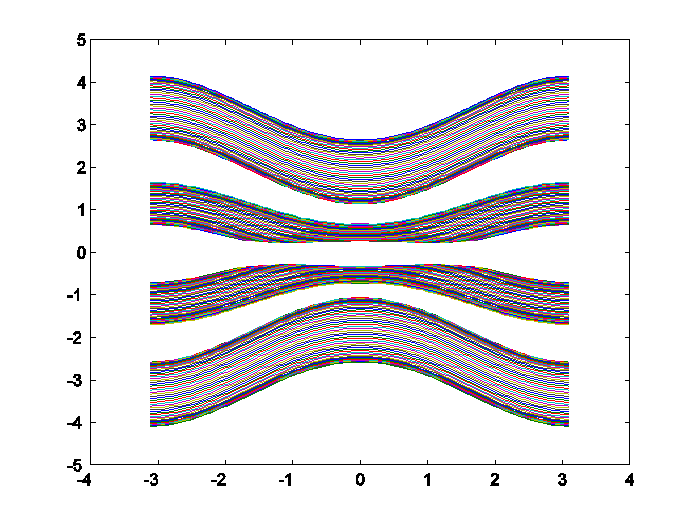
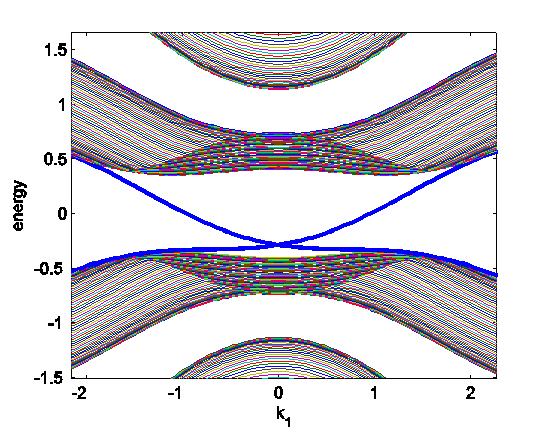
Fig.1. Left panel bulk spectrum of Fermi excitations in TI when intersite Coulomb interactions are taken into account. The additional bands are due to charge fluctuations. Right panel – the dispositions of the spectrum of edge states. It is essential the energies of edge states are spaced between the fluctuation state bands.
V.V. Val’kov
JETP Letters 114, issue12 (2021)
The vibration properties of a single crystal of yttrium iron garnet (Y3Fe5O12) were studied at high quasi-hydrostatic pressure by Raman spectroscopy. Raman spectra were measured with diamond anvil cells (DAC) in the pressure range of 0-72 GPa at room temperature. In the pressure region of ~ 50 GPa, a radical change in the spectra was found, indicating a phase transition. This correlates with the transition from the crystalline to the amorphous state, which was previously detected by the X-ray method, as well as with the metallization effect established from the optical absorption spectra. At this transition a spin crossover also undergoes in iron ions Fe3+, which transit from a high-spin state (HS, 3d5, S = 5/2) to a low-spin state (LS, 3d5, S = 1/2). In this work, the pressure dependences of the phonon modes in Y3Fe5O12 from ambient pressure to the critical pressure of the phase transition are documented in detail. To further study the unique electronic properties of Y3Fe5O12 garnet at pressures in the phase transition region, it is necessary to measure electrical resistance at high pressures and cryogenic temperatures.
The results of this study are very important, both for the physics of systems with strong electron correlations, and for geophysics, where various iron oxides are considered as one of the constituents of the Earth's mantle
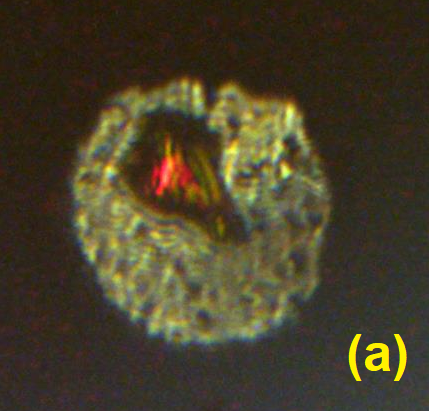
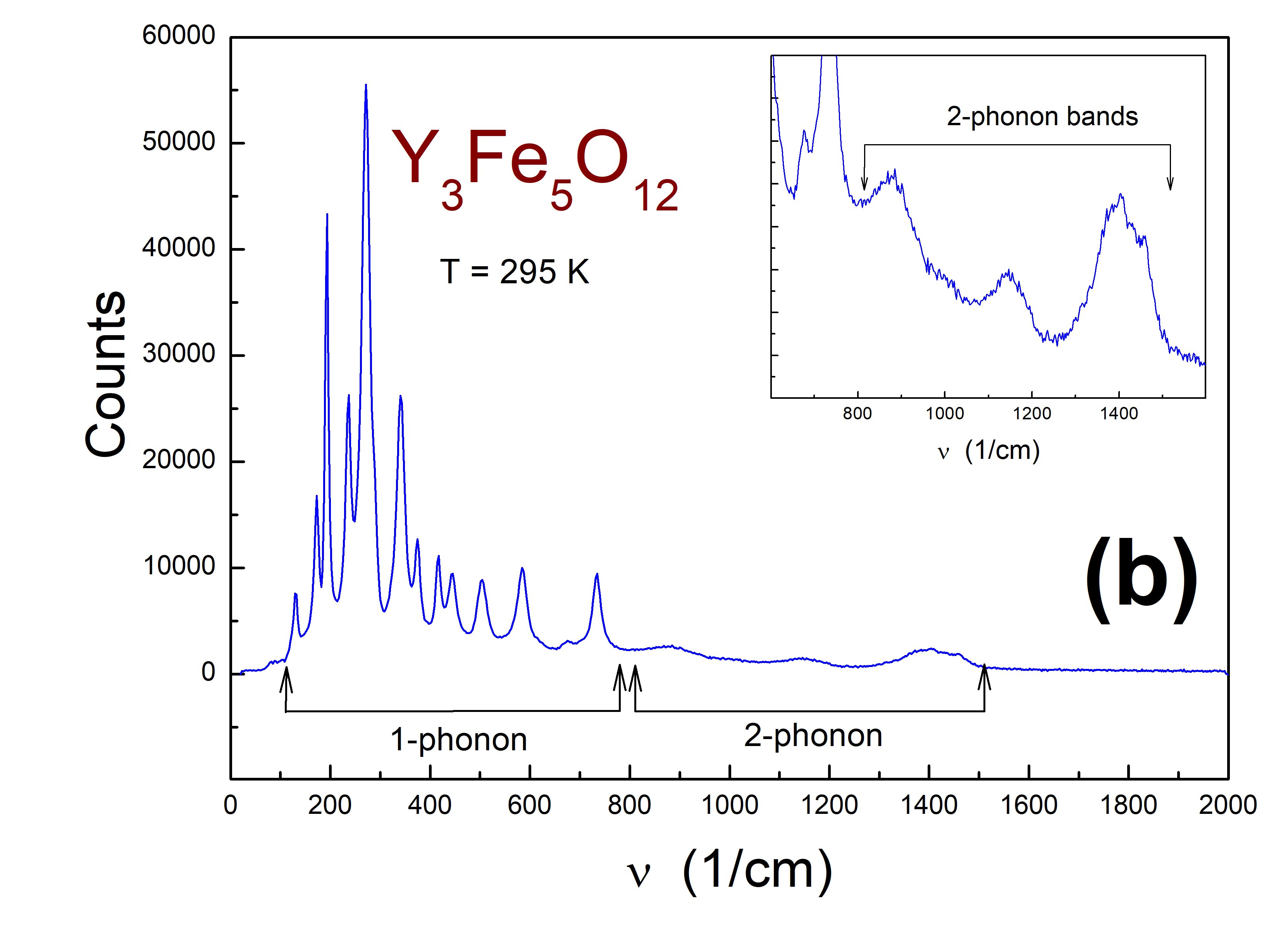
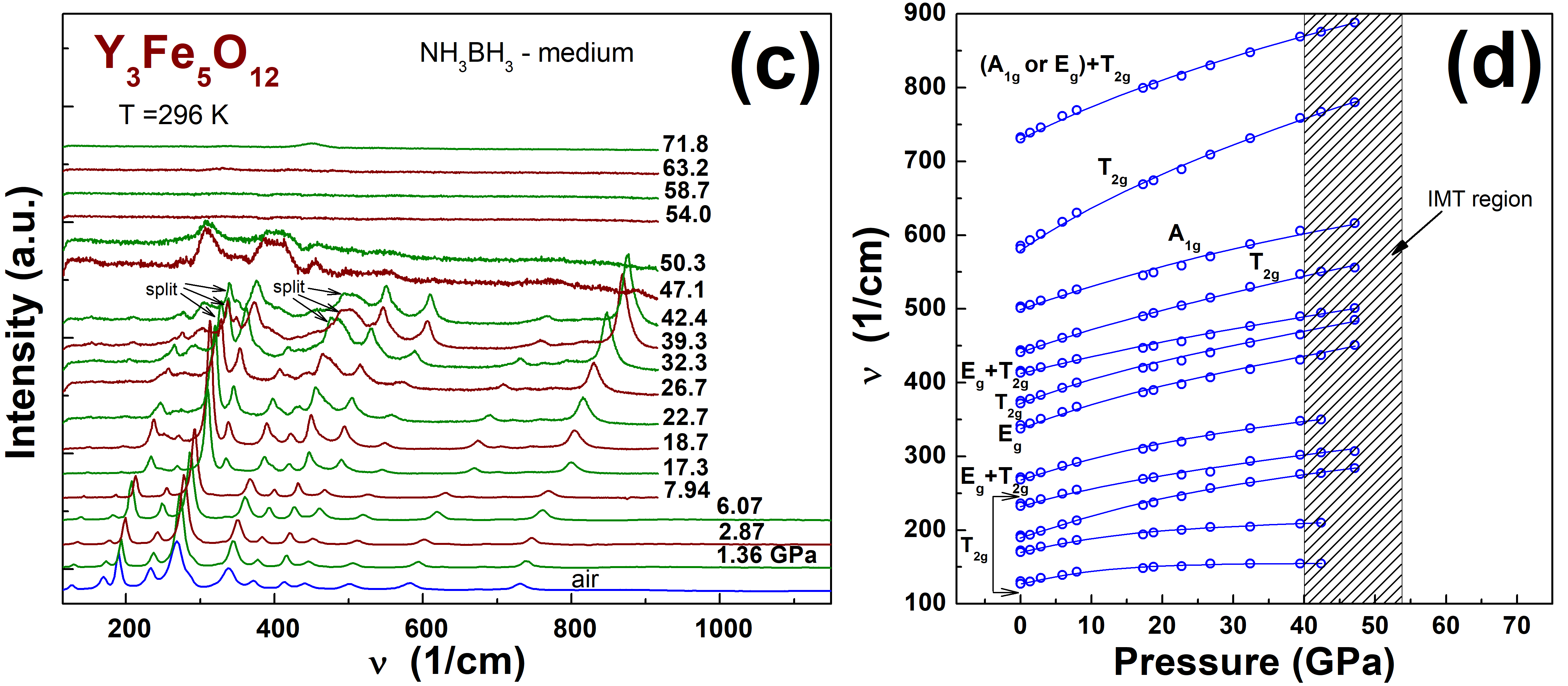
Figure 1. (a) Photo of a Y3Fe5O12 crystal ~ 10 μm thick in a DAC cell in an experiment with an NH3BH3 medium. (b) Raman spectrum of a Y3Fe5O12 crystal in different frequency ranges at ambient pressure and room temperature. (c) Evolution of the Raman spectra of the Y3Fe5O12 crystal with increasing pressure in the quasi-hydrostatic NH3BH3 medium, and (d) the dependence of the Raman frequencies on the pressure. The shaded area indicates the pressure range of the proposed dielectric-to-metal transition. At a pressure of ~ 47 GPa, the shape of the spectrum changes dramatically, indicating the onset of the phase transition, which ends after 54 GPa. The Raman spectra were excited using a COBOLT DPSS laser with a wavelength of 660 nm.
Aksenov S.N., Mironovich A.A., Lyubutin I.S., Troyan I.A., Sadykov R.A., Siddharth S. Saxena (Montu), Gavriliuk A.G.
JETP Letters 114, issue 12 (2021)
The interplay between nontrivial band structure and magnetic order in topological insulators is a rich source of remarkable quantum phenomena such as quantum anomalous Hall effect, axion electrodynamics, Majorana fermions, etc. These phenomena are manifested through topologically protected electron states appearing at the sample boundaries. A qualitatively new stage of investigations in this topic is triggered by the discovery of materials that combine topological properties with intrinsic antiferromagnetic order.
In this letter we present a theoretical investigation of modification of low-energy surface electron structure caused by the noncollinear magnetic domain walls in intrinsic antiferromagnetic topological insulator. The study is carried out on the basis of the Hamiltonian for quasirelativistic fermions by using a continual approach and tight-binding calculations. A bound one-dimensional state is shown to appear at the domain wall, in addition to the surface exchange gap modulation and the shift of a two-dimensional Dirac cone in momentum space. We describe the main characteristics of the bound state such as the energy spectrum (see the figure), spatial localization and spin polarization depending on orientation of domain magnetizations.
We consider possibilities of experimental observation of the bound states associated with the noncollinear magnetic domain walls and their contribution to quantum effects on the (0001) surface of the antiferromagnetic topological insulators of the MnBi2Te4 -type.

Spectral dependencies of the one-dimensional bound state (red color) induced by magnetic wall and projection of the Dirac cone two-dimensional states for different orientations of the domain magnetizations.
V. N. Men’shov, I. P. Rusinov, E. V. Chulkov
JETP Letters 114, issue 11 (2021)
Relativistic self-trapping of high-intensity ultra-short laser pulse (“laser bullet”) is manifested as formation of a 3D soliton structure in the form of a plasma cavity with evacuated background electrons filled by laser light and self-consistent plasma electric and magnetic fields – all propagating at almost speed of light in dense gas plasma. Such laser bullet propagates in plasma to distances exceeding the Rayleigh length considerably and requires certain matching of the size of the laser spot to the plasma density and the laser pulse intensity when the diffraction divergence is balanced by the relativistic nonlinearity such that the laser beam radius is unchanged during pulse propagation. Relativistic self-trapping of intense ultra-short laser pulse is similar to the so-called self-trapping of radiation of low-intensity quasi-stationary laser beam, which has been known since the 1960s for the quadratic nonlinearity of the medium’s dielectric permittivity and, as has been established now, takes place for the relativistic plasma nonlinearity as well.
Strong longitudinal plasma electric field of a laser bullet is able to accelerate significant number of electrons (up to tens of nC) with energies in the multi-hundred-MeV range. Currently, relativistic self-trapping is the best chose in terms of maximizing the total charge of the generated electron bunches for different applications, such as electron radiotherapy, radiation x-ray and gamma-ray sources, obtaining of photonuclear reaction products. However, the success in the implementation of such applications critically depends on the realization of the relativistic self-trapping mode in an inhomogeneous medium, since only this is possible in experiments.
This letter gives an answer to the possibility of self-trapping of extreme laser light (Fig. 1) in inhomogeneous plasma, that is important for targeted experiments. For the considered case of a near-critical density medium, (most promising for generation of high-current electron bunches) this letter is argued that relativistic self-trapping regime can be realized by proper focusing of a high-power laser pulse on a density profile at the vacuum-plasma interface. This justifies the possibility of creating an efficient source of high-energy electrons for socially significant applications.
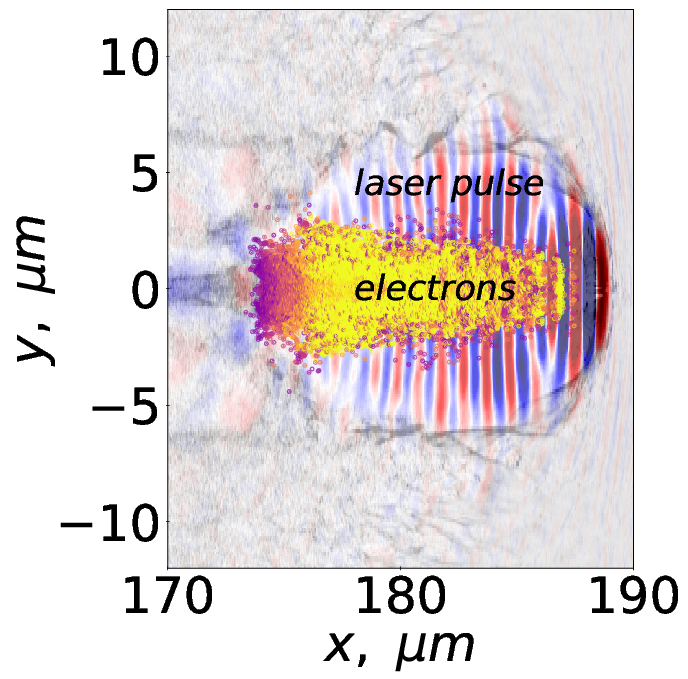
Fig.1 Plasma cavity with accelerated electrons for the relativistic self-trapping mode of laser pulse propagation.
V.Bychenkov, M.Lobok
JETP Letters 114, issue10 (2021)
We study the kinetics of long-lived cyclotron spin-flip collective exitations in a purely electronic quantum Hall system with filling factor $\nu=2$. The initial coherent state of the excitations with zero two-dimensional wave vector induced by laser pumping is stochastized over time due to emission of acoustic phonons. The elementary emission process requires participation of two excitations. So the effective rate of phonon emission is proportional to the excitation density squared, and the stochastization process occurs nonexponentially with time. The final distribution of these excitations over 2D momenta, established as a result of stochastization at zero temperature, is compared with equilibrium distribution at finite temperatures.
It is known that the lifetime of considered excitations (purely electronic spin-cyclotron excitons, SCEs) reaches a record magnitude, up to $1\,$ms, in a spin-unpolarised quantum Hall system. The decay of an initial coherent multi-excitonic state, where all excitations have equal 2D momenta ${\bf q}\!=\!0$, occurs into a diffusive incoherent state provided that the total number of excitations remains constant. When the `zero momentum' ensemble becomes stochastic, the main mass of excitons in the $K$-space diffuses to the vicinity of their energy $q$-dispersion minimum corresponding to a finite absolute value $q\!\approx\!0.9/l_B$ ($l_B$ is the magnetic length). In the future, the diffuse state is thermalized, and finally SCEs completely relax/annihilate. The stochastization occurs without any change of the spin state, thus, certainly, it is much faster than the total SCE-relaxation process. However, the stochastization is associated with emission of phonons and limited by the laws of conservation of energy and momentum. In the translationary invariant system, the one-exciton process associated with the emission of a phonon is kinematically forbidden: the energy and momentum preservation conditions are never fulfilled in the case.
We calculate the total probability $R_{ p}$ of transition of the coherent state to a state, where, due to the phonon emission, two SCEs acquire nonzero momenta, and one of them has a fixed value: ${\bf q}\!=\!{\bf p}$ .
The physical meaning of the value $R_{p}$ is that it represents the rate of appearance of a SCE with momentum ${\bf p}$ due to the considered process of direct transition from the coherent state. When studying the problem kinetically, it will mean the rate of filling of a `one-particle' excitonic state with specific momentum $p$. The total stochastization rate induced by phonon-emission, $R\!=\!\sum_{\bf p}R_p$, is the rate of appearance of nonzero-momentum SCEs. When dividing the `partial' rate $R_p$ by the total one $R$ we obtain a `one-particle' distribution function $F_p$ of nonzero excitons.
Value $F_p$ is time-independent and represents the final distribution function when only non-coherent excitations with nonzero momenta are present in the system. Our approach is suitable if the temperature is sufficiently low to ignore any phonon-absorption processes. In this case thermalization in the studied electron system should be a much longer process than the stochastization considered. It is interesting to compare the distribution function established due to stochastization to a thermodynamically equilibrium distribution corresponding to some temperature. The latter should be Boltzmann due to the assumed rarefaction of the exitonic gas. The time dependence of the coherent ensemble decay is parameterized by value ${\cal T}$ calculated for a specific GaAs/AlGaAs quantum well (see Fig. 1). The number of zero excitons decreases by half during time ${\cal T}\!/n(0)$ where $n(0)$ is the initial SCE concentration with respect to the density of magnetic flux quanta. A tenfold decrease takes time $\approx\!10{\cal T}\!/n(0)$, therefore, for $n(0)\!\leqslant\!0.01$ it occurs during $\gtrsim\!1\,\mu$s.
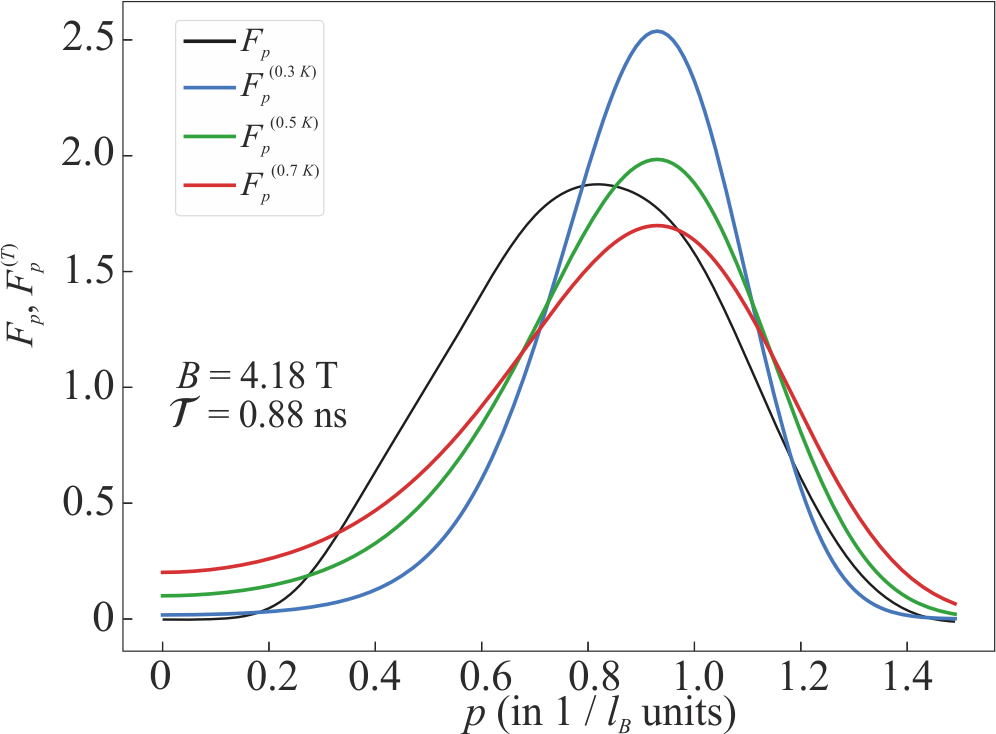
Caculated function $F_p$ of SCEs emerging due to the stochastization process (the black line), and the thermodynamically equilibrium distribution functions $F_p^{(T)}$ at different temperatures. All graphs correspond to $B=4.18\,$T.
Dickmann S., Kaysin B.D.
JETP Letters 114, issue 10 (2021)
In this work, an experimental scheme and results on direct detection of the normalized second-order correlation function g(2) of the optical-terahertz biphoton fields are demonstrated for the first time. Optical – terahertz biphotons, the quantum-correlated photon pairs consisting from one photon of optical frequency and one terahertz frequency photon, were generated via spontaneous parametric down conversion in a nonlinear crystal Mg:LiNbO3 pumped by nanosecond pulses of optical laser radiation. The terahertz part of the biphoton field was detected by an analog superconducting hot electron bolometer, the optical part was recorded using the single-photon avalanche photodiode or an analog photomultiplier tube. The methods developed for investigation and quantitative measuring of the quantum correlation characteristics of the optical – terahertz biphotons will be of key importance in future applications of quantum optical technologies, such as quantum sensing, photometry, ghost imaging, in the terahertz frequency range.
The left figure shows the pump power dependences of the biphoton correlation function g(2). The values of g(2) were obtained with a specially proposed heralding method for discrimination of noise readings of the analog bolometer which were recorded simultaneously with the noise samples from the single-photon optical detector. The direct measuring results are in a good agreement with theoretical predictions on the quantum excess of g(2) over its classical level 1 for the multimode field. Another method of direct discrimination of the readings below some selected threshold values, applicable to readings of both analog optical and terahertz receivers, was tested at different threshold levels. The right figure demonstrates dependence of the effective correlation function geff, evaluated by this method, on the threshold signal and idler photocurrents. It is shown that application of this method makes it possible to register high effective levels of biphoton correlation due to attraction of additional contributions from correlation functions of higher orders.
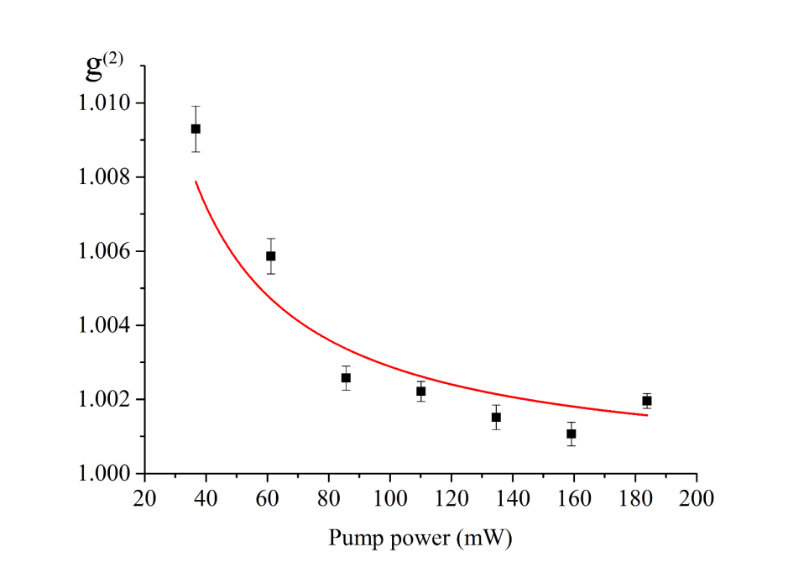
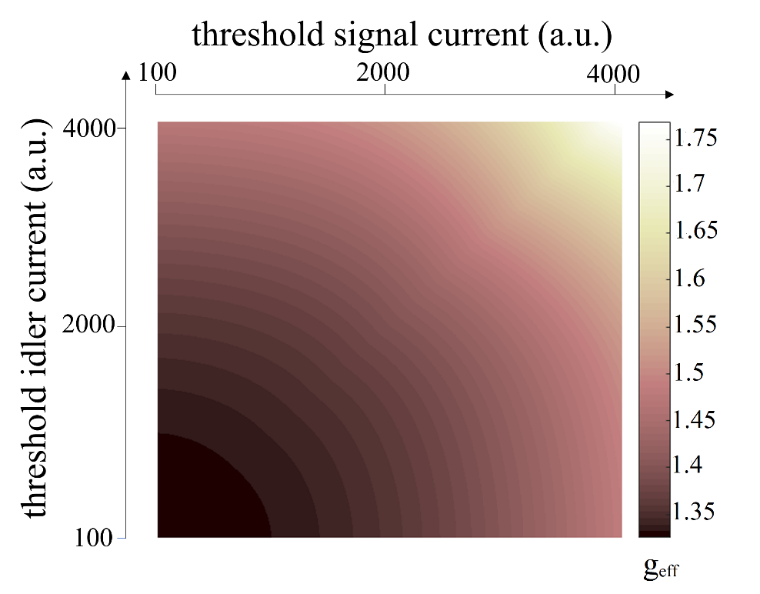
Left: Pump power dependences of the normalized second-order biphoton correlation function g(2).
Right: Threshold signal and idler current dependences of the effective biphoton correlation function geff.
A.A. Leontyev, K.A. Kuznetsov, P.A. Prudkovskii, D.A. Safronenkov, G.Kh. Kitaeva
JETP Letters 114, isuue 11 (2021)